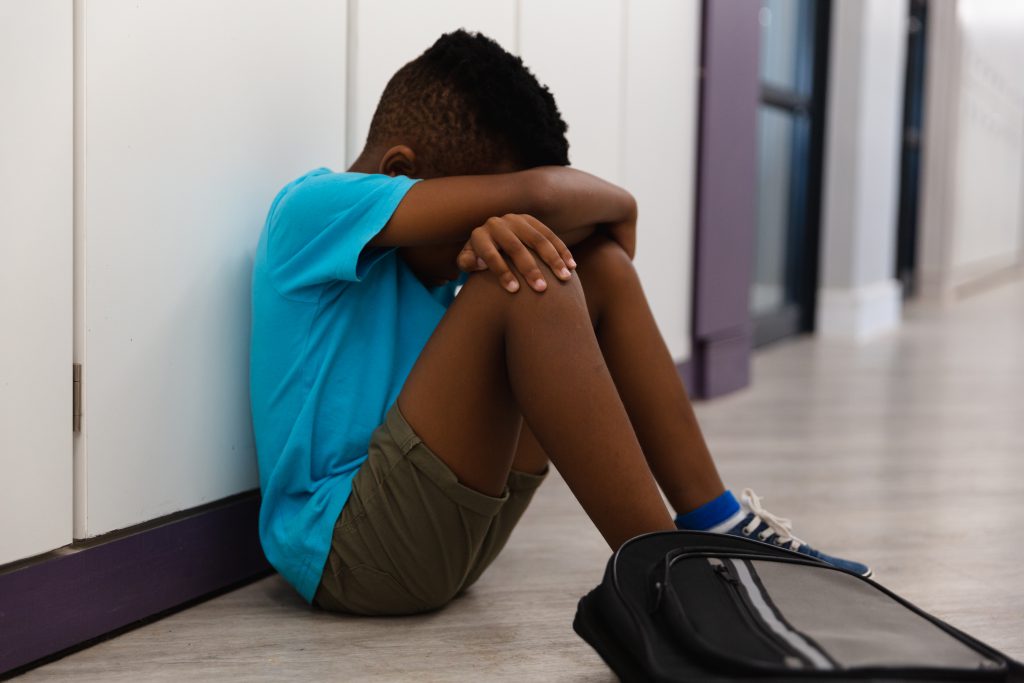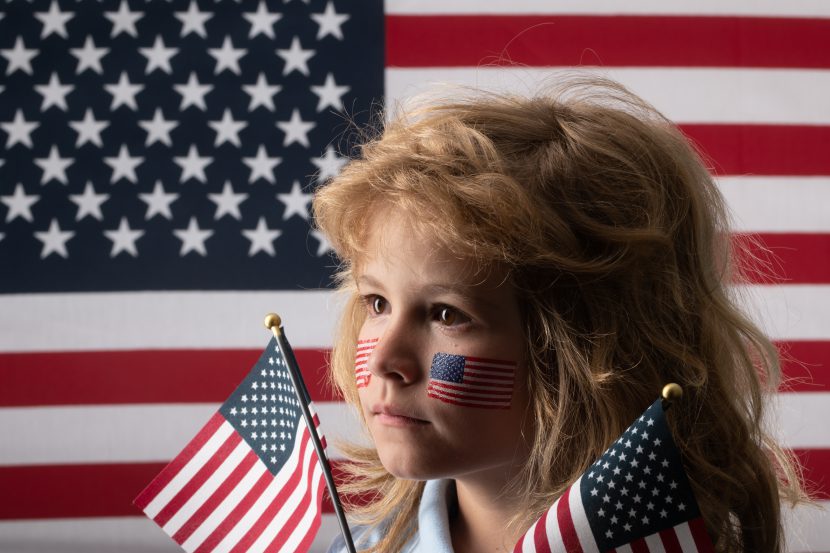The UN Convention on the Rights of the Child (CRC) is the most ratified international human rights treaty. Since its adoption in 1989, 196 countries have ratified the CRC, including Somalia and South Sudan which ratified it in 2015 (OHCRC, 2022). To date, the United States (US) is the only country in the world that hasn’t ratified the CRC.
Many people in the US assume that, even without ratification of the CRC, the US upholds international children’s rights principles, but the reality is still far from reaching this goal. In fact, most US states are overwhelmingly noncompliant with international children’s rights standards, especially with those related to child marriage, corporal punishment, child labor, and juvenile justice.
Why hasn’t the US ratified the CRC?
The US played a big role in shaping the CRC. During negotiations in the 1980s, the Reagan administration proposed seven of the CRC’s articles, more than any other country (Becker, 2019). The contribution was decisive in relation to the following articles: Article 10 (family reunification), Article 13 (freedom of expression), Article 14 (freedom of religion), Article 15 (freedom of association and assembly), Article 16 (right to privacy), Article 19 (protection against all forms of violence), Article 25 (periodic review of treatment). The US influence was so strong that some people referred to the CRC as the “US child rights treaty” (Cohen, 2006). Nevertheless, to date, the US still has not ratified the CRC (OHCRC, 2022).
The main argument raised against ratifying the CRC is that it is “anti-family” and a threat to parental authority. This is far from the truth. Not only does the CRC highlights the importance of the family as an instrument for child development (Todres, 2006)but it also instructs governments to “respect the responsibilities, rights and duties of parents” (Article 5 CRC) and to support families in their efforts to raise and care for their children. In fact, references to the importance of the parent-child relationship appear throughout the text (Becker, 2019). Moreover, every action undertaken by the parents must respect children’s rights, according to the best interest of the child (Couzens, 2007).
Another argument which explains the opposition against the ratification of the CRC on the part of the US is related to the CRC’s possible impact on the US sovereignty and on state and federal laws (CRS Report, 2015). This theory is based on a misreading of international instruments and their impact on national legislation.
First, the CRC does not provide for the establishment of special courts to oversee the application of the treaty standards and it does not provide for sanctions or other forms of reinforcement. The Committee on the Rights of the Child is an independent body of the United Nations responsible for the implementation and monitoring of the CRC through a reporting mechanism (Todres, 2006). Nevertheless, the Committee on the Rights of the Child does not have specific powers to enforce compliance with the CRC.
US states fail to protect children’s rights
Many people in the US assume that, even without ratification of the CRC, the US upholds international children’s rights principles. On the basis of this assumption, the Human Rights Watch (HRW) designed an interactive scorecard to assess states’ performance on all children’s rights enshrined in the CRC in four different dimensions: child marriage, corporal punishment, child labor, and juvenile justice (HRW, 2022).
The choice of focusing on individual US states comes with the fact that many of the issues addressed by the CRC are left to the jurisdiction of individual states, not the federal government. As a result, the protection and advancement of children’s rights vary from state to state (HRW, 2022).
Moreover, the scorecard targets four dimensions which were selected based on an initial review of areas in which the US does not comply with the CRC at the federal level and where the Convention has established age-based or otherwise measurable metrics to compare specific state laws against (HRW – US States Fail to Protect Children’s Rights, 2022).
Child marriage
Child marriage is defined as a marriage in which one or both parties are under the age of 18. According to the international standard set by the CRC, states parties have the “obligation to recognize that persons up to the age of 18 years are entitled to continuing protection from all forms of exploitation and abuse” (General Comment No. 20), including child marriage. In fact, the minimum age limit for marriage should be 18 years.
Child marriage is associated with early pregnancy, lower educational achievement, and increased risk of domestic violence and poverty. It follows cultural and socio-economical patterns which hinder the well-being of the child and their development.
To date, child marriage is legal in forty-three US states. Before 2018, the year Delaware became the first US state to prohibit child marriage, it was legal in all fifty US states. On July 28, 2022, Massachusetts became the seventh state to set the minimum age at 18, without exceptions, in line with international standards (WHR, 2022).
Between 2000 and 2018, nearly 300,000 minors were legally married in the US, While most of them were aged 16 or 17, a few were as young as 10 (Unchained at Last, 2021).Most child marriages in the US are girls marrying adult men. In fact, many of these marriages occurred at an age or with a spousal age difference that would typically be considered sexual violence (HRW, 2022).
Corporal punishment
According to the international standard set by the CRC, state parties have the “obligation to protect children from all forms of physical and mental violence” (Article 19 CRC). The CRC “does not leave room for any level of legalized violence against children” and that “corporal punishment and other cruel or degrading forms of punishment are forms of violence and states must take all appropriate legislative, administrative, social and educational measures to eliminate them” (General Comment No. 8, 2007).

In reality, approximately 160,000 children are subjected to corporal punishment in schools each year. Black children and children with disabilities are significantly more likely to experience corporal punishment in schools (Gershoff and Font, 2016). Only two states have prohibited corporal punishment in both public and private schools, complying with the CRC.
Twenty-five states have outlawed corporal punishment in public schools only, meaning children who attend private schools may still be subject to corporal punishment at school. Meanwhile, in twenty-three states, corporal punishment is not prohibited in either public or private schools (HRW, 2022).
Moreover, 49 percent of all children aged 0-9 years old in the US are subjected to corporal punishment in the home. Not a single US state has banned corporal punishment in the home setting (Gershoff and Font, 2016).
On the other hand, the use of corporal punishment in alternative care settings has historically been widespread and severe, particularly against children with disabilities (Global Initiative to End All Corporal Punishment of Children, 2012). This is the reason why most of the US states have banned corporal punishment in alternative care settings (HRW, 2022).
Child labor
According to the international standard set by the CRC, state parties have the “obligation to protect children from work that is hazardous or harmful to their health, safety, education, and moral development” and requires state parties to set a minimum age for employment (Article 32 CRC).Moreover, the minimum age for employment is 15 (General Comment No. 20, 2016) and the minimum age for employment in hazardous conditions is 18 (ILO Convention No. 138, 1976). These principles apply also to the agricultural sector.
In reality, weak protections in federal child labor law and regulations in the US fail to protect children working in agriculture, the most dangerous industry for child workers. Federal law allows children to work for hire in agriculture at younger ages, for longer hours, and in more hazardous conditions than in any other sector (HRW, 2022). According to the US Government report in 2018 (United States Government Accountability Office, 2018), children working in agriculture account for more than half of work-related fatalities, even though they represent just three percent of child workers
Juvenile justice
Juvenile justice refers to the treatment of children in conflict with the law. According to the international standard set by the CRC, state parties have the “obligation to prevent children and young people from engaging in criminal activities as well as to protect the human rights of youth already found to have broken the law” (Articles 37 and 40 CRC).According to Article 40 of the CRC, the minimum age of juvenile jurisdiction should be at least 14 years old, and states are encouraged to set it at 16 (General Comment No. 24, 2019).
The US remains the only country in the world that sentences children under 18 to life in prison without parole, which the CRC strictly prohibits. At the beginning of 2020, more than 1,400 people were serving life-without-parole sentences in the US for offenses committed as children, in some cases as young as aged 13 (Rovner, 2021). 62 percent of those serving sentences of life without parole for childhood offenses are Black, though they make up only 14 percent of the US youth population.
International children’s rights standards state that no child should be prosecuted as an adult. Nevertheless, an estimated 53,000 children are tried in adult courts each year (Mistrett and Espinoza, 2021). None of the fifty US states prohibits prosecuting children in adult courts, and only twenty-eight states have any age limits on transferring children to adult courts.
Not a single state sets the minimum age of juvenile jurisdiction to at least 14 (the international standard) and more than 30,000 children under 12 are referred to juvenile court annually (Abrams, 2020). Only five states set a minimum age higher than 10. Moreover, corporal punishment in child penal institutions remains legal in sixteen states (HRW, 2022).
The “American story” mismatches with the reality most children live
The situation portrayed in the previous sections represents a reality that mismatches the idea most people have about American children. In fact, child marriage, child labor, violence against children and juvenile justice are some of the issues which still affect a large part of the US youth population, even if this piece of news is not part of the “American story” that media, newspapers and social media tell.

It is important to go beyond appearances in order to acquire a clear description of reality and, thanks to that, advocate for improvements in children’s rights and protection, as well as promote solutions. In this sense, Humanium is on the front line in this mission. In fact, Humanium continues to promote reflections about burning issues which are not widespread, and which significantly affect children’s rights. If you want to contribute to this cause, feel free to consider sponsoring a child, making a donation, or becoming a volunteer with our organization. Take action now to protect and promotes the rights of the youngest among us!
Written by Arianna Braga
References:
Abrams L. S. et al. (2020). When Is a Child Too Young for Juvenile Court? A Comparative Case Study of State Law and Implementation in Six Major Metropolitan Areas, in Crime & Delinquency, vol. 66, no. 2 (2020): pp. 219–49. Retrieved from: https://doi.org/10.1177/0011128719839356, accessed on 8 October 2022.
Becker, J. (2019). America Should Not Lag Behind on Protecting Children. Retrieved from: https://www.hrw.org/news/2019/11/18/america-should-not-lag-behind-protecting-children, accessed n 8 October 2022.
Cohen, C. P. (2006). The Role of the United States in the Drafting of the Convention on the Rights of the Child, in 20 EMORY INT’L L. REV. 185, 2006, p. 190. Retrieved from: https://jjustice.org/wp-content/uploads/History-of-CRC.pdf, accessed on 8 October 2022.
COUZENS M., Autonomy Rights versus Parental Autonomy, in A. Alen et al. (a cura di), The UN Children’s Rights Convention: theory meets practice: International Interdisciplinary Conference on Children’s Rights, Antwerpen, Intersentia, 2007.
CRS Report (2015). The United Nations Convention on the Rights of the Child. Retrieved from: https://crsreports.congress.gov/product/pdf/R/R40484/25, accessed on 8 October 2022.
General Comment No. 20 (2016). United Nations Committee on the Rights of the Child (CRC), General Comment No. 20, Implementation of the rights of the child during adolescence, CRC/C/GC/20 (2016), https://digitallibrary.un.org/record/855544?ln=en (accessed June 14, 2022).
General Comment No. 20 (2016). United Nations Committee on the Rights of the Child (CRC), General Comment No. 20, Implementation of the rights of the child during adolescence, CRC/C/GC/20. Retrieved from: https://digitallibrary.un.org/record/855544?ln=en, accessed on 8 October 2022.
General Comment No. 24 (2019). UN Committee on the Rights of the Child, General Comment No. 24, Children’s Rights in the Child Justice System, U.N. Doc. CRC/GC24 (2019), para 22. Retrived from: https://www.ohchr.org/en/documents/general-comments-and-recommendations/general-comment-no-24-2019-childrens-rights-child, accessed on 8 October 2022.
General Comment No. 8 (2007). UN Committee on the Rights of the Child, General Comment No. 8, The right of the child to protection from corporal punishment and other cruel or degrading forms of punishment, CRC/C/GC/8 (2007). Retrieved from: https://digitallibrary.un.org/record/583961?ln=en, accessed on 8 October 2022.
Gershoff, E. T. and Font, S. A. (2016). Corporal Punishment in U.S. Public Schools: Prevalence, Disparities in Use, and Status in State and Federal Policy. Social Policy Report, vol. 30, no. 1. Retrieved from: https://srcd.onlinelibrary.wiley.com/doi/10.1002/j.2379-3988.2016.tb00086.x, accessed on 8 October 2022.
Global Initiative to End All Corporal Punishment of Children (2012). Ending legalised violence against children: Prohibiting and eliminating corporal punishment in all alternative and day care settings. Retrieved from: https://bettercarenetwork.org/sites/default/files/attachments/Ending%20Legalised%20Violence%20Against%20Children.pdf, accessed on 8 October 2022.
HRW (2022). How Do US States Measure Up on Child Rights? Retrieved from: https://www.hrw.org/feature/2022/09/13/how-do-states-measure-up-child-rights, accessed on 8 October 2022.
HRW – US States Fail to Protect Children’s Rights (2022). US States Fail to Protect Children’s Rights. Retrieved from: https://www.hrw.org/news/2022/09/13/us-states-fail-protect-childrens-rights, accessed on 8 October 2022.
ILO (2022). What Is Child Labour. Retrieved from: https://www.ilo.org/ipec/facts/lang–en/index.htm, accessed on 8 October 2022.
ILO Convention No. 138 (1976). ILO Convention No. 138 concerning the Minimum Age for Admission to Employment (Minimum Age Convention), adopted June 26, 1973, 1015 U.N.T.S. 297, entered into force June 19, 1976.
Mistrett M. and Espinoza M. (2021). Youth in Adult Courts, Jails, and Prisons. Retrieved from: https://www.sentencingproject.org/publications/youth-in-adult-courts-jails-and-prisons/, accessed on 8 October 2022.
OHCRC (2022). Retrieved from: https://tbinternet.ohchr.org/_layouts/15/TreatyBodyExternal/Treaty.aspx?Treaty=CRC&Lang=en, accessed on 8 October 2022.
Rovner J. (2021). Juvenile Life Without Parole: An Overview. Retrieved from: https://www.sentencingproject.org/publications/juvenile-life-without-parole/, accessed on 8 October 2022.
TODRES J., Analysing the opposition to U.S. ratification of the U.N. Convention on the Rights of the Child, in J. Todres et al., The: U.N. Convention on the Rights of the Child: an Analysis of Treaty Provisions and Implications of U.S. Ratification, Ardsley, Transnational Publishers, 2006.
Unchained at Last (2021). United States’ Child Marriage Problem. Retrieved form: https://www.unchainedatlast.org/united-states-child-marriage-problem-study-findings-april-2021/, accessed on 8 October 2022.
United States Government Accountability Office (2018). Working children – Federal Injury Data and Compliance Strategies Could Be Strengthened. Retrieved from: https://www.gao.gov/assets/gao-19-26.pdf, accessed on 8 October 2022.
WHO Child maltreatment (2022). Child maltreatment. Retrieved from: https://www.who.int/news-room/fact-sheets/detail/child-maltreatment, accessed on 8 October 2022.
WHO Violence against children (2022). Violence against children. Retrieved from: https://www.who.int/health-topics/violence-against-children#tab=tab_1, accessed on 8 October 2022.


